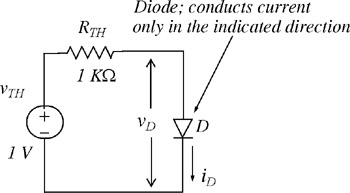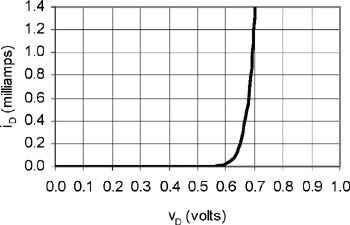Circuit Analysis I with MATLAB Applications

Most electronic circuits contain non-linear devices such as diodes and transistors whose i v (current-voltage) relationships are non-linear. However, for small signals (voltages or currents) these circuits can be represented by linear equivalent circuit models. A detailed discussion of these is beyond the scope of this text; however we will see how operational amplifiers can be represented by equivalent linear circuits in the next chapter.
If a circuit contains only one non-linear device, such as a diode, and all the other devices are linear, we can apply Thevenin's theorem to reduce the circuit to a Thevenin equivalent in series with the non-linear element. Then, we can analyze the circuit using a graphical solution. The procedure is illustrated with the following example.
Example 3.13
For the circuit of Figure 3.63, the i v characteristics of the diode D are shown in Figure 3.64. We wish to find the voltage v D across the diode and the current i D through this diode using a graphical solution.


Solution:
The current i D through the diode is also the current through the resistor. Then, by KVL
or
or
We observe that (3.61) is an equation of a straight line and the two points are obtained from it by first letting v D = 0, then, i D = 0. We...
